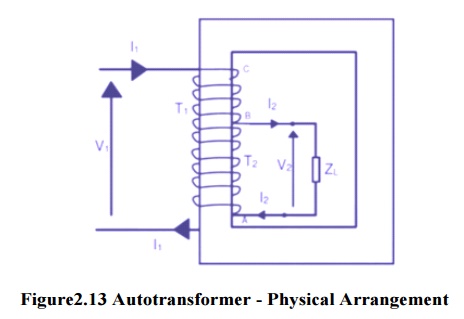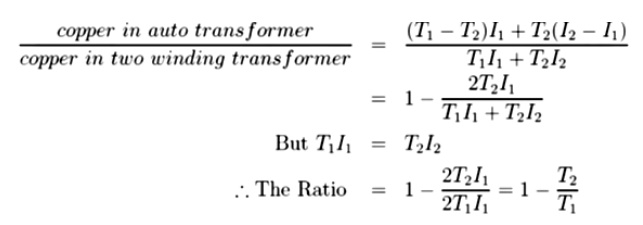Chapter: Electrical machines : Transformer
Auto Transformer
Auto Transformer

The
primary and secondary windings of a two winding transformer have induced emf in
them due to a common mutual flux and hence are in phase. The currents drawn by
these two windings are out of phase by 180◦. This prompted the use of a part of
the primary as secondary. This is equivalent to fusing the secondary turns into
primary turns. The fused section need to have a cross sectional area of the
conductor to carry (I2−I1) ampere! This ingenious thought
led to the invention of an auto transformer. Fig. 28 shows the physical
arrangement of an auto transformer. Total number of turns between A and C are
T1. At point B a connection is taken. Section AB has T2 turns. As the volts per
turn, which is proportional to the flux in the machine, is the same for the
whole winding,
V1
: V2 = T1 : T2 (76)
For
simplifying analysis, the magnetizing current of the transformer is neglected.
When the secondary winding delivers a load current of I2 ampere the
demagnetizing ampere turns is I2T2 . This will be countered by a current I1
flowing from the source through the T1 turns such that,
I1T1
= I2T2 (77)
A current
of I1 ampere flows through the winding between B and C . The current
in the winding between A and B is (I2 − I1) ampere. The
cross section of the wire to be selected for AB is proportional to this current
assuming a constant current density for the whole winding. Thus some amount of
material saving can be achieved compared to a two winding transformer. The
magnetic circuit is assumed to be identical and hence there is no saving in the
same. To quantify the saving the total quantity of copper used in an auto
transformer is expressed as a fraction of that used in a two winding
transformer as,

This
means that an auto transformer requires the use of lesser quantity of copper
given by the ratio of turns. This ratio therefore denotes the savings in
copper. As the space for the second winding need not be there, the window space
can be less for an auto transformer, giving some saving in the lamination
weight also. The larger the ratio of the voltages, smaller is the savings. As
T2 approaches T1 the savings become significant. Thus auto
transformers become ideal choice for close ratio transformations. The savings
in material is obtained, however, at a price. The electrical isolation between
primary and secondary
Related Topics